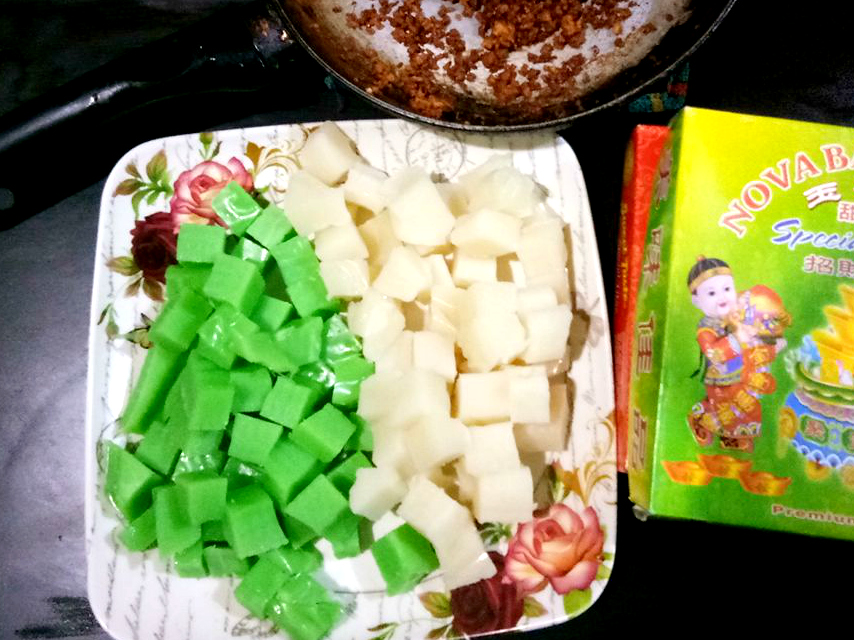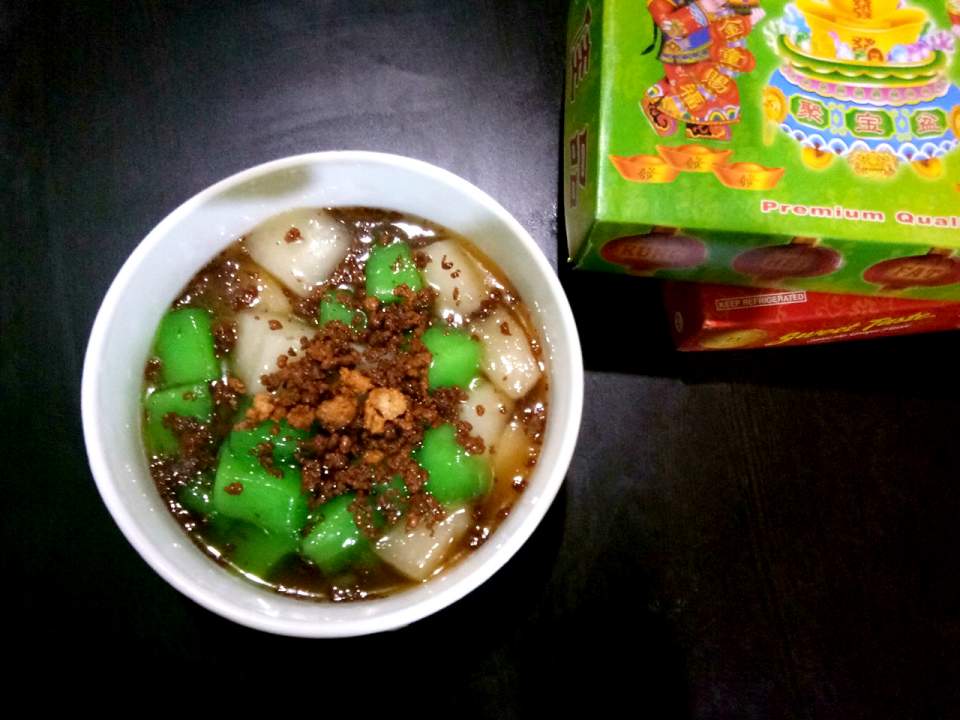What Is Tikoy and Why We Get So Much of It
The Chinese New Year is coming up again and if you’re like me, who have generous Filipino-Chinese friends, bosses, or colleagues, you’ll have dozens of tikoy in the refrigerator before the end of February. They love giving away this sticky and sweet glutinous rice cake (also called nian gao) as a symbol of prosperity and abundance.
And here’s the funny thing: abundance becomes its own challenge. How do you eat all that tikoy before it hardens in the cold? This is where Filipino kitchens shine. We’re masters of adaptation. We fry tikoy with egg, we pan-toast it with sugar, and in my house, we turn it into something that reminds me of home in the province: tikoy sa latik.

Tikoy Meets Latik: A Filipino Twist on a Chinese New Year Dessert
Tikoy, in Chinese culture, is meant to bind families together and make luck stick for the year ahead. In Filipino culture, glutinous rice already plays the same role, like think kalamay, biko, sapin-sapin, suman. To put tikoy and latik together is like a quiet handshake between two traditions, saying: your symbol of prosperity, our language of sweetness.
I like this hybrid because it feels festive in the way Filipino food always leans festive. Latik transforms tikoy into something closer to our fiestas, where no food is plain and nothing is ever too much. The golden curds of coconut oil are our signature—simple tikoy suddenly wears the extravagance of a town celebration.
Colors of Celebration
When I see flavored tikoy in purple, green, yellow, I think of how we Filipinos love to play with color in our sweets. Sapin-sapin with its rainbow layers. Pichi-pichi rolled in white coconut. Even kutsinta now comes topped with bright orange cheese. Food isn’t just eaten; it has to look alive.
This sense of spectacle ties tikoy to our own calendar of celebrations. The colors remind me of pahiyas in Lucban, where kiping in brilliant hues covers entire houses. Or Christmas lanterns in December, glowing like candy in every street. Tikoy may begin as a solemn round cake meant for good luck, but in Filipino kitchens it bursts into play, just like our fiestas do.
Creative Tikoy sa Latik Recipe
Today, I’m sharing a really simple and creative Tikoy Recipe, adapted to the Filipino taste buds. This is best for your leftover tikoy and is actually one of the creative ways to enjoy Tikoy for Chinese New Year .
It’s called Tikoy sa Latik, patterned after our Filipino Kalamay sa Latik, a specialty glutinous dessert in the Southern Tagalog regions. The kalamay (or in this case, the tikoy) is drenched in sugar syrup then topped with latik and sweet langka. Unfortunately, I have no Langka today, but it’s okay. The tikoy recipe can stand on its own. Maybe you can also add those colored sago for a more festive look.
I learned this Tikoy recipe last year when I was looking for what to do with leftovers Chinese food at the Ifoodala Food Group in Facebook and its been a hit at home so I’m making them again this year. You can have a choice of different colors and flavors. Eng Bee Tin has several. There’s also ube, pandan, sweet corn, and even munggo flavored tikoy.
It’s really good and super easy! The smell of the latik was super awesome as I was making this. My little one, who is not feeling so good today mustered the strength to ask what I was cooking, thank goodness. In reverse, you can also use this recipe for Kalamay sa Latik!

Ingredients
- 2 small box of Tikoy cut in small squares
Latik
- 2 cups Coconut Cream
Arnibal
- 2 cups dark brown sugar
- 2 cups water
Instructions
- Prepare the latik by gently simmering the coconut cream. Latik is created when oil is separated from the cream and the cream becomes curds. Watch it when it begins to boil so your latik will not burn. I tried creating this using canned coconut cream before but it did not have as many latik as I expected. Set the latik aside.
- Prepare your arnibal or sugar syrup by mixing water and sugar in a pan. Allow to boil till syrupy.
- Add the Tikoy to the boiling arnibal and stir for about 3 minutes or until TIkoy is done. Do not overcook or the Tikoy will melt.
- Serve your Tikoy sa Latik and enjoy!
- (PS, be careful, its hot!)
Tikoy sa Latik FAQs
Can I use canned coconut cream to make latik?
Yes, you can, but fresh coconut cream (kakang gata) creates more latik and has better flavor. If using canned cream, choose one with no added stabilizers and simmer it gently so it doesn’t scorch.
How do I store leftover tikoy sa latik?
Keep it in an airtight container in the refrigerator for up to 3 days. Reheat gently in a pan or microwave with a splash of water to soften.
What other toppings can I use for tikoy sa latik?
You can add sweetened langka strips, colored sago, or even grated cheese for a fiesta-style look. These toppings add texture and playfulness without overwhelming the tikoy.
Can I make tikoy sa latik using flavored tikoy?
Absolutely. Ube, pandan, sweet corn, or munggo-flavored tikoy all work well. The color adds visual appeal and ties perfectly to Filipino celebrations.
Can I use this recipe for leftover kalamay?
Yes. This method also works for kalamay or other sticky rice-based sweets. Just stir the cut pieces in arnibal until warm and soft, then top with latik.
Prosperity, Adapted
Tikoy sa latik is a small proof of how Filipino kitchens turn gifts into something new, how abundance is never wasted but remade. In the bubbling coconut cream and the sugar’s slow boil, we translate prosperity into our own language of fiesta and color.
Happy Chinese New Year! May your year be sticky with sweetness and bright with adaptation.


